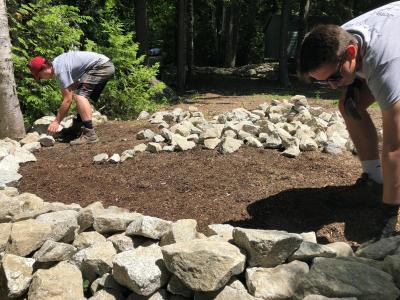Youth Conservation Corps
7 Lakes Alliance is home to Maine’s largest Youth Conservation Corps (YCC), which employs students to reduce sources of pollution in our lakes by installing lakeshore erosion control projects. Working with homeowners, businesses and municipalities, the YCC installs rain buffer gardens, armored shorelines and ditches, infiltration steps and trenches, and erosion control mulch at more than 100 sites annually. 
Soil from exposed eroding sites is the most prevalent form of lake pollution in Maine. Decreasing soil erosion in the watershed protects water quality. Some best management practices (BMPs) you or YCC can install:
- Buffer gardens are vegetated buffers along the shoreline, ditches and streams. They slow the flow of runoff into the lake, allowing excess surface water (carrying phosphorus) to infiltrate back into the ground. Buffers can be composed of native trees and shrubs, landscaped gardens of flowering shrubs or perennials, or a combination of these.
- Riprap is rock armoring for eroding shorelines. When waves, ice and boat wakes impact a shoreline, the resulting erosion can deposit soil and nutrients into the lake (along with eating away at your shoreline). Large angular rocks absorb the energy of waves and ice, protecting the shoreline from erosion. YCC cannot install rip rap if there is no buffer above it.
- Rain gardens are depressions that collect rain runoff from impervious surfaces and allow stormwater to infiltrate into the soil rather than flowing quickly and carrying soil with it. Rain gardens do not hold standing water; water enters the soil within a few hours of a storm. During dry periods, a rain garden is simply an attractive landscape feature.
- Infiltration trenches and dry wells, like rain gardens, collect and infiltrate stormwater. Trenches are filled with crushed stone that provide porous material to collect runoff. Infiltration trenches along drip lines are an effective tool to prevent erosion caused by roof runoff.
- Infiltration steps are timber steps filled with crushed stone. These steps prevent erosion from foot traffic and runoff on steep slopes. They also provide attractive, safe paths on lakefront properties.
- Ditches and culverts are subject to erosion from heavy runoff. Armoring these areas with stone can prevent sediment from being carried into water bodies downstream. Check dams or plunge pools help slow the flow of water in ditches and collect sediment.
- Rubber razor blades and other water-diverting tools such as open-top culverts can help direct runoff away from roads and driveways. Though these structures are not suitable for plowed roads, on seasonal roads, they are effective in preventing erosion.
The Conservation Corps also stabilizes exposed soil and eroded footpaths with erosion control mulch (ECM) and by vegetating eroding slopes and diverting runoff into wooded areas.
YCC is a low-cost option for landowners seeking to protect lakes from erosion pollution. Sign up for a YCC project by emailing ycc@7lakesalliance.org. However, the wait for a YCC project is more than a year because of inadequate funding. Donations to the program can be made here.

